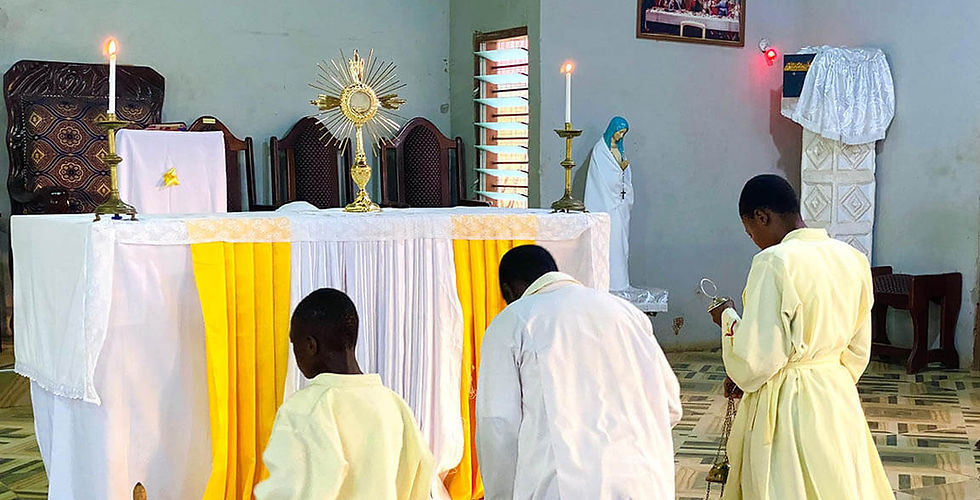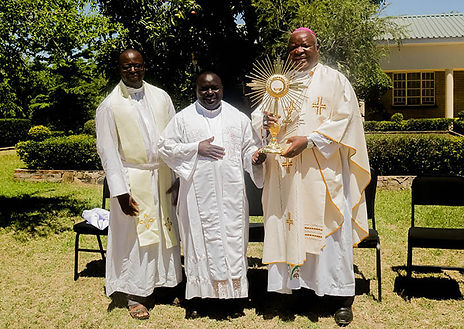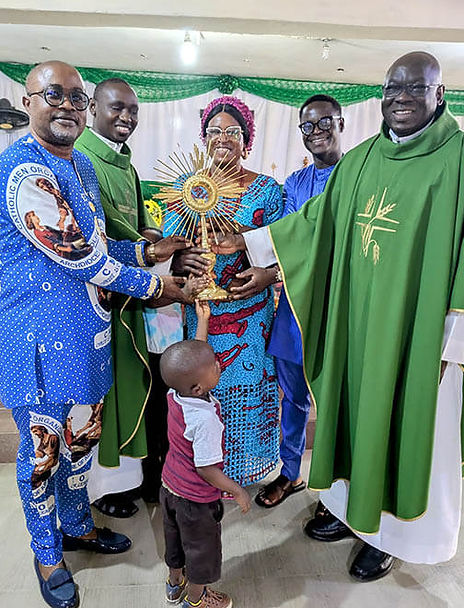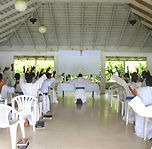
Share the blessings of Eucharistic Adoration

It’s how we develop our relationship with the Lord, opening the door to growth and authentic love … Through Eucharistic Adoration, we are blessed with the opportunity to spend time with Jesus as we pray before and reflect upon the exposed Blessed Sacrament. Adoration blesses entire parishes, as well. Communities anchored in Christ can withstand any challenge or change.
As a devout Catholic, you understand how critical this silent time with Jesus is. It gives you a feeling of peace, deepens your belief in His Real Presence and power, and inspires greater hunger in your heart for communion with God. Yet parishes around the world lack a resource essential for Adoration: the monstrance that holds and displays the Body of Christ!
Catholic World Mission emphasizes evangelical revival and spiritual development. We provide underprivileged parishes and communities with monstrances to foster increased devotion to the life-giving power of the Eucharist. Will you help us?
.jpg)
Bishop Martin Mtumbuka of the Diocese of Karonga, Mallawi.

Rev Fr. Sebastian Musa presented the Monstrance from the Catholic World Mission to the parishioners of St. Agnes Catholic Church, Abuja, Nigeria.
Your loving offering today will grace Catholics around the world with the chance to transform their souls through Eucharistic Adoration. You’ll help purify hearts and unite the global Church.
God bless you for your devotion to the Faith!
GIVE NOW!
Delivering Monstrances Around the World

Catholic World Mission strongly emphasizes evangelistic revival and spiritual development in its core values. Our latest endeavor involves providing underprivileged parishes and communities with monstrances to foster increased devotion to the life-giving power of the Eucharist.
“The love of God and neighbor, the greatest commandment, is expressed in, and the fruit of Eucharistic worship.”
– St. John Paul II
Whats is Adoration?

Eucharistic Adoration is a Catholic tradition in which we get to be in the presence of the exposed Blessed Sacrament. The Body of Christ is held in a monstrance and stationed in a designated space, usually the altar or chapel, which allows us to have personal, tranquil, and uninterrupted time with Jesus. A consecrated host, one that has been transformed at Mass to the actual Body of Christ, is removed from the tabernacle. While the tabernacle does hold the consecrated hosts, is available for prayer, and given reverence, the Eucharist is still covered, concealed, and usually locked inside. For Eucharistic Adoration, the host is placed in a monstrance that contains a glass compartment (called a luna) and exposes the Eucharist before all. The exposition of the Blessed Sacrament proves to be the key and most important factor of Eucharistic Adoration. If the parish chooses to only have particular hours for Eucharistic Adoration, an ordained minister will repose the Blessed Sacrament and place it back in the tabernacle. The exposition of the Blessed Sacrament serves as an extension of the adoration and praise of the Body and Blood of Christ during the Mass. Eucharistic Adoration allows us to acknowledge the strength and almighty power of our Lord and Savior. During this time of reverence, visitors may pray, recite the rosary, read scripture, offer intentions, or simply sit in the presence of the Lord. Open to anyone, Eucharistic Adoration also assigns the visiting adorers the responsibility of being a guardian to the Blessed Sacrament. This silent period of time with Jesus gives many people the blessing of internal peace, greater hunger for Communion with God, and deepened assurance in His power and presence.
When did Adoration Start?

The origins of Eucharistic Adoration can be dated back to the time of Jesus’s first apostles. These evangelists strongly emphasized the physical presence of Christ in the Eucharist and its role in being a continuation of Jesus’s saving mission. These evangelists strongly emphasized the physical presence of Christ in the Eucharist and its role in being a continuation of Jesus’s saving mission. Influenced by this faith, early hermits would conceal and often preserve the Eucharist in their caves for safekeeping. They would also carry the Eucharist on their person when traveling. By the Fourth Century, the Eucharist was commonly reserved in monasteries and convents and served the primary purpose of reaching the sick and dying. The keeping of the Blessed Sacrament in religious houses became very guarded, often under lock and key. The 11th century brought extremely controversial voices that rejected and criticized the physical transformation of bread and wine into the Body and Blood of Christ. Pope Gregory VII, defending against this heresy, clarified the Church’s teaching on the Eucharist: Jesus is truly and actually present in the Eucharist. This clarification created various gateways for visits, viewings, and adoration of the Blessed Sacrament. This “eucharistic renaissance” brought about a more open and available worship of the Blessed Sacrament. Since then, the ability to adore and be before the Eucharist has developed greatly and continues to move the hearts of countless individuals and communities.
Why would I do go to Adoration?

By attending Eucharistic Adoration, we are accepting an invitation from Jesus to grow closer to Him. With the presence of the exposed and physical being of Christ, God reveals his tenderness to us in the silence. With the presence of the exposed and physical being of Christ, God reveals his tenderness to us in the silence. By allowing God into our hearts, He gives strength and hope to those who wander or are lost. Eucharistic Adoration blesses one with a temporary escape from the secular world to bring our struggles before God. Away from noise and distractions, adoration opens an opportunity for healing, guidance, enlightenment, forgiveness, and peace.
Who can Participate?

Anyone is welcome to visit and pray with the Blessed Sacrament. God makes his grace available to all his children. From individuals to groups to entire parishes, Eucharistic Adoration is offered to all for petitions and thanksgiving.
Does Adoration Benefit the Community?

It does! The tradition of Eucharistic Adoration also brings an abundance of blessings for the parish. Whether attending on a whim, on your own schedule or signing up for a specific guardian time, attending adoration increases your involvement in parish life. Exposition of the Blessed Sacrament offers a place for the community to come together in deep prayer and adoration. God pours out his love and support to parishes in need. Parishes that become anchored in Christ in this way are able to withstand any challenge, change, or shortcoming. The Eucharist is also a sign of personal communion with God. The more we develop this spiritual relationship on a personal, individual level, the better we get at developing an authentic love of neighbor, which strengthens the parish family.
About Eucharistic Miracles

Sts. John Fisher (1469-1535) and Thomas More (1478-1535) were strengthened in life and prepared for martyrdom by fervent adoration of the Blessed Sacrament. In one of More’s prayers, published after his death, we read, “O sweet Saviour Christ, by the diverse torments of Thy most bitter Passion, take from me, good Lord, this lukewarm fashion or rather key-cold meditation, and this dullness in praying to Thee. And give me Thy grace to long for Thy Holy Sacraments, and especially to rejoice in the Presence of Thy Blessed Body, sweet Saviour Christ, in the Holy Sacrament of the Altar, and duly to thank Thee for Thy gracious visitation therewith.”

St. Margaret Mary Alacoque (1647-1680), a Visitation nun, found that the Blessed Sacrament gave her the strength she needed to endure what witnesses at her beatification process declared were “contempt, contradictions, rebukes, insults, reproaches, without complaining, and praying for those by whom she was ill-treated.”

On August 18, 1996, Father Alejandro Pezet was saying an evening Mass at a Catholic church in central Buenos Aires. Upon finishing distributing communion, a woman came forward and informed him that a discarded host had been seen on a candleholder in the back. Unable to consume the host, Father Peret placed the Blessed Sacrament in a vessel of water in the tabernacle to allow it to dissolve. The following Monday, Father Peret was astonished to find that the host had transformed into a significantly larger and bloody substance. Kept in secret and rejecting decomposition, the host was under lock for a few years.
Cardinal Bergoglio, now Pope Francis, had the substance scientifically analyzed by various specialists who determined that the mysterious substance came from an actual piece of human flesh. More specifically, it was announced to be a part of the left cardiac ventricle, a muscle responsible for pumping blood to the rest of the body. Furthermore, scientists concluded that due to an inflamed condition and an excess amount of white blood cells, the heart must have been alive when the sample was taken and had undergone severe amounts of stress.
PROGRAM UPDATES
Your Support Creates Lasting Impact
Your generous donations to Catholic World Mission have a direct and meaningful impact on the lives of those in need. By contributing to our cause, you are helping us meet basic needs and share the love of Christ with communities worldwide. We provide regular updates through photographs and videos, allowing you to witness the immediate difference your donation makes. We encourage you to support our mission and donate to Catholic World Mission today.
















